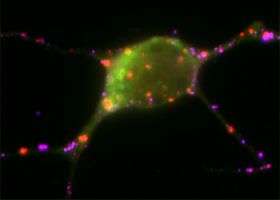A molecule keeps anxiety down

(PhysOrg.com) -- The link between emotions and experiences determines many aspects of our daily life. It allows us to recognize pretty objects or harmful situations. These links are created when nerve cells construct new connections to one another or reinforce existing connections. Scientists at the Max Planck Institutes for Neurobiology and Psychiatry and at the Großhadern Clinic (Ludwig Maximilian University) have now discovered a molecule with a crucial influence on the strength of these connections (PNAS, August 4, 2008).
When a child touches a hot plate on a stove, it will more than likely be the first and last time. The reason for this rapid learning process lies in the amygdala, a small area in the brain that links experiences to emotions. In this area, the hot plate, the pain experience and a low level of fear are linked together - and the child avoids touching the hot plate in the future.
While this link from fear to experiences frequently protects the body from injury, an incorrect or inappropriate link can result in serious problems. One example is phobias, in which relatively harmless objects or situations are connected to fear. How do the nerve cells form these links and how are they regulated?
Memories and also fear-experience links are created when nerve cells form new contacts or reinforce existing contact to neighbouring cells. So-called Eph receptors are important for signal transmission at these contact points. They sit on the surface of the nerve cells and have an antenna-like function. If a neighbouring cell with the correct binding partners binds to these receptors, the signal is transmitted more strongly. The fewer Eph receptors a cell has on its surface, the weaker the communication with other nerve cells - and it becomes more difficult to link emotions to experience in the amygdala.
Scientists at the Max Planck Institutes for Neurobiology and Psychiatry and the Großhadern Clinic at the Ludwig Maximilian University have been researching a molecule that controls the number of Eph receptors on the surface of nerve cells. Called Rin1, the molecule ensures that Eph receptors are transported in larger numbers from the cell surface to the cell interior.
If there is no Rin1 in the amygdala nerve cells of a mouse, the number of Eph receptors remains high. The result is a stronger signal transmission between the nerve cells - the molecular basis for a heightened fear response. On the other hand, if the Eph receptor is missing, the communication between the nerve cells is not strengthened and it seemingly becomes more difficult to link the emotion with the experience.
Rin1 is the first module known to limit the availability of Eph receptors in the adult brain. "We are gradually starting to understand how emotions are linked to experiences on a molecular level," says Rüdiger Klein, who headed the study. This understanding is the key to developing potential medicines. "Basic knowledge, such as the regulation of the Eph receptors by Rin1, could permit us in the future to improve the poor transmission of signals between the nerve cells or to eliminate damaging links," says Katrin Deiniger, who hopes to see this as the long-term objective of their study. That is a promising perspective, as Eph receptors play an important part in other processes, for example in the development and regeneration of the nervous system.
Citation: Katrin Deininger, Matthias Eder, Edgar R. Kramer, Walter Zieglgänsberger, Hans-Ulrich Dodt, Klaus Dornmair, John Colicelli, Rüdiger Klein; The Rab5 guanylate exchange factor Rin1 regulates endocytosis of the EphA4 receptor in mature excitatory neurons; PNAS, August 4th, 2008
Provided by Max Planck Institute of Neurobiology




















